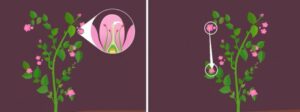Table of Contents
Class 6 Biology Introduction to Pollination
Table of Contents
- Pollination
- Types of Pollination
- Self-pollination
- Cross-pollination
- Pollinating agents
- Abiotic Pollinating Agents
- Biotic Pollinating Agents
- Summary
- What’s Next?
In the previous segment, we glanced at the functions of different parts of the flower. In this segment, we will learn about different types of pollination and pollinating agents.
What is Pollination?
Pollination is the process in which pollen grains from the anther are transferred to the stigma of the same or different flower.
What are the different types of pollination?
There are two types of pollination: self-pollination and cross-pollination.
- What is Self-pollination?
When the pollination occurs in the same flower or different flowers of the same plant, it is called Self-pollination.

What is Cross-pollination?
Cross-pollination is the process of transferring pollen from the male organ or stamen of one flower to the female organ or pistil of another flower. This can be done by hand, or by wind, insects, or other animals. Cross-pollination is important for plants because it allows them to mix their genes and create new and different varieties of plants.
Also Read: Types of Pollination – Self Pollination and Cross Pollination
Pollinating agent
- Pollination is the process of transferring pollen from the male anther of a flower to the female stigma of a flower. It is necessary for the fertilization of the ovules and the production of seed. Pollination can be done by wind, water, or animals, but the most common agent is bees.
- Bees are important pollinators because they are able to fly from flower to flower, and they have a long tongue that can reach the nectar inside the flowers. They also collect pollen on their bodies, which they spread to other flowers as they visit them.
- Many fruits and vegetables are pollinated by bees, including apples, pears, cherries, strawberries, and cucumbers. By pollinating these crops, bees play a vital role in the production of food.
- Pollination is also necessary for the reproduction of many plants, including flowers, fruits, and vegetables. Without pollination, these plants would not be able to produce seed or fruit.
- Pollination is an important process that helps to produce food and reproduce plants. Bees are the most common pollinators, and they play a vital role in the pollination of many crops.



